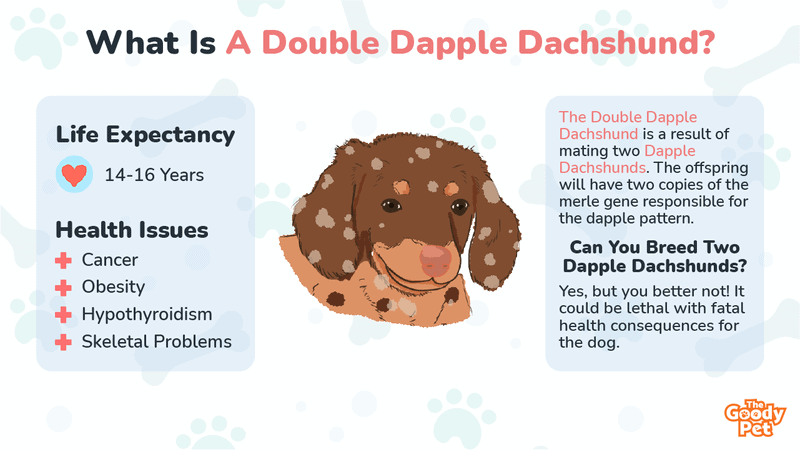Dapple pattern Doxies are, without a doubt, among the cutest little doggies you will ever lay your eyes on. What’s more, is that they actually have the personality to match. I have, however, always found it hard to differentiate between dapple double dapple weenie dogs.
So when I was considering getting a double dapple of my very own, I had to do a whole lot of research to finally figure things out. Here is what I learned about these loving and absolutely lovable little pooches.
A Double Dapple Dachshund is a breed variant of the Dachshund that is known for its distinctive coat markings. It is a result of mating two Dapple Dachshunds. The offspring will have two copies of the merle gene responsible for the dapple pattern. The double-action of this pattern control gene results in the unique markings that set it apart from single dapples and other coat pattern variants of the Dachshund breed.
Double Dachshunds are incredibly unique both in terms of their coat patterns and the overall experience you have to look forward to if you want to own one of your own. To help you out, here is all the information you need to understand the breed so that you explicitly know what you are getting yourself into.
What Is The Difference Between Dapple And Double Dapple?

Both the dapple and double dapple Dachshund variants have the merle gene in common. This affects the pattern of colors on the dog’s coat. It also plays a role in health issues, especially when it comes to pigment-associated development of the visual and auditory systems.
One of the main differences between these two is how the genes are transmitted and appear in the resulting pup. The merle gene is a dominant type of gene. This means that only one parent needs to have it for the puppy to demonstrate dapple features.
With single dapple Doxies, the dog only has one copy of the gene. This happens when another dapple breeds with a typical Dachshund. With double dapples, on the other hand, the sausage dog ends up with two copies of the merle gene. This is a result of two dapple Dachshunds mating with each other.
One of the best ways to tell a dapple Dachshund apart from a double dapple Dachshund physically is through the coat patterns.
Single dapples usually have a single base color and spots or specks of a different single color scattered randomly all over the body. The color combinations vary and include different pairings of black, tan, brown, red, and blue.
On the other hand, the double dapple has white markings due to the lack of pigmentation caused by the presence of two merle genes. These white spots appear on the neck, nose, paws, and tail. They sometimes also have blue eyes.
This combination of features is how you can tell if a Dachshund is a double dapple.
Is It Safe To Breed Two Dapple Dachshunds?

Technically speaking, you can breed a dapple and a dapple but you shouldn’t. Sometimes it is considered lethal with fatal health consequences for the adorable little pooch. However, there have been cases where the resulting double dapple Dachshunds survived without complications and lived long and healthy lives.
Ethically speaking, it is best not to risk it, as things can really go wrong for the little ones. So if you really must have one, then it is best to go with existing rescues instead of ordering a designer double dapple through a breeder.
It is so frowned upon, actually, that the American Kennel Club and several other regional regulators refuse to register the double dapples.
So what is the big fuss all about? The issue is that when mating two dapple Doxies together, you pass two merle genes to the puppy. This is a problem because, in addition to determining the coat pattern, this gene plays a role in the manifestation of several health issues.
By having two copies of the gene, the double dapple pup is significantly more likely to develop the associated complications. In some instances, the presence of two copies actually intensifies some of these conditions making life a lot harder for the little one than it really should be.
In a nutshell, it really is not worth the risk despite the fact that it is technically possible and legally acceptable. It is just way too big of a risk with serious consequences to the life quality of the little dog.
Serious Health Problems Of A Double Dachshund

One of the main reasons why the intentional breeding of dapple Doxies is so controversial is the fact that double dapples have bad health outcomes. In addition to the normal health issues suffered by normal weenies, these dogs have to deal with the risk of other congenital illnesses as a result of the merle gene.
For some perspective, let us look at what a double dapple may have to suffer.
Due To The Merle Gene
Eye Problems
Double Dachshunds face a high risk of being born with absent or malformed eyes, congenital blindness, glaucoma, as well as cataracts that may develop later on in life. This is more likely to happen with double dapples with blue eyes.
Ear Problems
The merle gene affects pigmentation processes involved in the development of the auditory system. In addition to congenital deafness, the dog may also suffer abnormalities of the ear lobes, including odd shapes and sizes or a complete absence of the lobes.
Common To Doxies
Intervertebral Disk Disease
This is associated with spinal cord issues like compression and prolapse that, in addition to being excruciatingly painful, may also affect the mobility of the dog. If not dealt with promptly, the pooch may even end up completely paralyzed.
Obesity
This is associated with back and joint issues, the dog’s high appetite, and overall high risk of weight issues common with small dogs. Fixing the problem should be a high priority before complications, like diabetes and heart disease, arise.
Cancer
This includes skin cancers, hemangiosarcomas, reproductive system tumors, and many others that are among the leading causes of death in Doxies
How Long Do Double Dapple Dachshunds Live?

How long a double dapple Dachshund lives depends on several factors. This includes the presence of merle-specific complications, overall health status, nutrition, and much more. For the most part, if a Double Dapple Doxie is healthy and well-taken care of, it can live as long as any regular Dachshund, with an average lifespan of 14 to 16 years.
However, if they have health issues, this number may be reduced to as little as 7 to 10 years. This is the case, particularly with life-threatening conditions that affect the double dapple and other Dachshunds in general. The most common culprits, in this case, are obesity, heart disease, and shunts.
Obesity is especially nasty in that it kills the doggy slowly and in such a non-dramatic way that it may not seem like too much of a priority to deal with. The reality is that underneath all those extra rolls of body fat lie silent killers like diabetes, hypertension, and cardiac diseases just tearing into the life span range.
Life for these loving and playful little doggies is also often cut short by cancer. Fortunately, these are diseases of old age and usually appear above the age of 7 years old, with most Double Dapple Dachshunds.
While these dogs do have several health issues, the good news is that, more often than not, they are not life-threatening. The only thing you have to worry about, specifically with double dapples, is complications of the sensory impairment. In this case, the associated trauma is the biggest issue that causes accidental deaths in all age groups for the dog.
What’s The Difference Between Piebald And Dapple?

While I was doing my research on dapple vs. double dapple, I came across the piebald Dachshund variety and got plunged into even deeper confusion. This is another coat variant of the weenie associated with a genetic mutation. Let us take a look at what makes it different from the double dapple.
Genes
As earlier stated, dapple Dachshunds are a result of the presence of the merle gene. It is a dominant type of gene which means that only one parent needs to have the copy for the physical features to appear in the dog.
Piebald Doxies, on the other hand, have the piebald gene. This one is a recessive type of gene which means two parents with the variant have to mate to produce offspring with the specific markings.
Coat Patterns
Both the dapple and piebald genes affect the coat pattern, but they do so in different ways.
The merle gene causes the appearance of one color of spots or specks on a different color of base coat. The spots and base appear in different patterns of black, brown, blue, or red hues.
On the other hand, the piebald gene manifests as dark patches and spots on a white or cream coat.
Health Issues
Both dapples and piebalds suffer from health issues that commonly affect Doxies, including skeletal problems, obesity, hypothyroidism, and allergies.
The merle and piebald genes also contribute to pigment-associated visual and auditory deficits. However, the merle gene is more aggressive in this case, with more common and worse health effects.
Related Questions
How Much Are Double Dapple Dachshunds? Double dapple Doxies are not commonly bred and sold, and as a result, there aren’t enough consistent price ranges. You should budget around $1,500, which is what single dapple pups go for. On the other hand, Double Dapple Dachshund rescues are cheaper and more ethically sourced than those bred explicitly for sale.
Are All Double Dapple Dachshunds Blind And Deaf? Not all Double Dapple Dachshunds are blind and/or deaf. The merle gene is associated with sensory anomalies in different manifestations and to different degrees, and for the most part, Double Dapples are more likely to suffer than Single Dapple dogs. However, a few are fortunate enough to escape this and lead normal and healthy lives.
What Is A Hidden Dapple Dachshund? Also known as a cryptic Dapple Dachshund, this refers to Doxies with the merle gene where the spots are not immediately visible, especially at birth. It is common with darker base coat colors and long smooth fur texture. The red coat variant is the most commonly affected and is often associated with blue eyes, which is how they are best identified.





